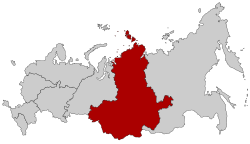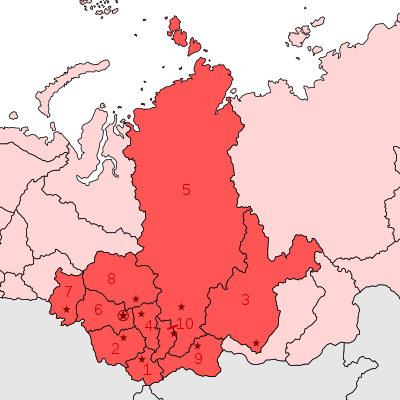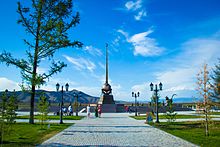| This article needs additional citations for verification. Please help improve this article by adding citations to reliable sources. Unsourced material may be challenged and removed. Find sources: "Siberian Federal District" – news · newspapers · books · scholar · JSTOR (July 2012) (Learn how and when to remove this message) |
Federal district in Russia
| Siberian Federal District Сибирский федеральный округ | |
|---|---|
| Federal district | |
 Location of the Siberian Federal District Location of the Siberian Federal District | |
| Country | |
| Established | 13 May 2000 |
| Administrative centre | Novosibirsk |
| Government | |
| • Presidential Envoy | Anatoly Seryshev |
| Area | |
| • Total | 4,361,800 km (1,684,100 sq mi) |
| • Rank | 2nd |
| Population | |
| • Total | 17,178,298 |
| • Rank | 3rd |
| • Density | 3.8/km (10/sq mi) |
| GDP | |
| • Total | ₽ 13.054 trillion US$ 187 billion (2022) |
| • Per capita | ₽ 781,580 US$ 11,182 (2022) |
| Time zones | |
| Omsk Oblast | UTC+06:00 (Omsk Time) |
| most of the district | UTC+07:00 (Krasnoyarsk Time) |
| Irkutsk Oblast | UTC+08:00 (Irkutsk Time) |
| Federal subjects | 10 contained |
| Economic regions | 2 contained |
| HDI (2022) | 0.768 high · 6th |
| Website | SFO.gov.ru |
| = | |
 class=notpageimage|
class=notpageimage| Siberian Federal District (Russian: Сибирский федеральный округ, IPA: [sʲɪˈbʲirskʲɪj fʲɪdʲɪˈralʲnɨj ˈokrʊk]) is one of the eight federal districts of Russia. Its population was 17,178,298 according to the 2010 Census, living in an area of 4,361,800 square kilometers (1,684,100 sq mi). The entire federal district lies within the continent of Asia.

The district was created by presidential decree on 13 May 2000 and covers around 30% of the total land area of Russia. In November 2018, Buryatia and Zabaykalsky Krai were removed from the Siberian Federal District and added to the Far Eastern Federal District in accordance with a decree issued by Russian President Vladimir Putin.
Demographics

Federal subjects
The district comprises the West Siberian (part) and East Siberian economic regions and ten federal subjects:

| ||||||||
|---|---|---|---|---|---|---|---|---|
| # | Flag | Coat of arms | Federal subject | Area in km | Population (2021) | GDP | Capital/adm. center | Map of administrative division |
| 1 | 
|
Altai Republic | 92,900 | 210,924 | ₽71 billion | Gorno-Altaysk | ||
| 2 | 
|
Altai Krai | 168,000 | 2,163,693 | ₽845 billion | Barnaul | ||
| 3 | 
|
Irkutsk Oblast | 774,800 | 2,370,102 | ₽1,924 billion | Irkutsk | 
| |
| 4 | 
|
Kemerovo Oblast | 95,700 | 2,600,923 | ₽1,807 billion | Kemerovo | 
| |
| 5 | 
|
Krasnoyarsk Krai | 2,366,800 | 2,856,971 | ₽3,065 billion | Krasnoyarsk | 
| |
| 6 | 
|
Novosibirsk Oblast | 177,800 | 2,797,176 | ₽1,617 billion | Novosibirsk | ||
| 7 | 
|
Omsk Oblast | 141,100 | 1,858,798 | ₽854 billion | Omsk | 
| |
| 8 | 
|
Tomsk Oblast | 314,400 | 1,062,666 | ₽706 billion | Tomsk | ||
| 9 | 
|
Tuva Republic | 168,600 | 336,651 | ₽89 billion | Kyzyl | ||
| 10 | 
|
Republic of Khakassia | 61,600 | 534,795 | ₽308 billion | Abakan | 
| |
| Year | Pop. | ±% |
|---|---|---|
| 1959 | 15,102,916 | — |
| 1970 | 16,209,665 | +7.3% |
| 1979 | 17,094,856 | +5.5% |
| 1989 | 18,658,624 | +9.1% |
| 2002 | 17,926,354 | −3.9% |
| 2010 | 17,178,298 | −4.2% |
| 2021 | 16,800,947 | −2.2% |
| Source: Census data | ||

Religion and ethnicity
| Religion in the Siberian Federal District as of 2012 (Sreda Arena Atlas) | ||||
|---|---|---|---|---|
| Russian Orthodoxy | 28.9% | |||
| Other Orthodox | 1.9% | |||
| Other Christians | 5.2% | |||
| Islam | 1.4% | |||
| Buddhism | 1.2% | |||
| Native faiths | 1.6% | |||
| Spiritual but not religious | 33.2% | |||
| Atheism and irreligion | 18.7% | |||
| Other and undeclared | 7.9% | |||
According to a 2012 survey, 28.9% of the population of the current federal subjects of the Siberian Federal District (excluding Buryatia and Zabaykalsky Krai) adhere to the Russian Orthodox Church, 5.2% are unaffiliated generic Christians, 1.9% are Orthodox believers without belonging to any church or adhere to other (non-Russian) Orthodox churches, 1.4% are Muslim, 1.2% are Buddhist, and 1.6% adhere to some native faith such as Rodnovery, Tengrism, or Tuvan Shamanism. In addition, 33.2% of the population declare to be "spiritual but not religious", 18.7% are atheist, and 7.9% follow other religions or did not give an answer to the question.

Ethnic composition, according to the 2010 census:
- Total – 19,256,426
- Russians – 16,542,506 (85.91%)
- Buryats – 442,794 (2.30%)
- Tuvans – 259,971 (1.35%)
- Ukrainians – 227,353 (1.18%)
- Tatars – 204,321 (1.06%)
- Germans – 198,109 (1.03%)
- Kazakhs – 117,507 (0.61%)
- Altaians – 72,841 (0.38%)
- Khakass — 70,859 (0.37%)
- Armenians – 63,091 (0.33%)
- Azerbaijanis – 54,762 (0.28%)
- Belarusians – 47 829 (0.25%)
- Uzbeks – 41,799 (0.22%)
- Chuvash – 40,527 (0.21%)
- Tajiks – 32,419 (0.17%)
- Kyrgyz — 30,871 (0.16%)
- Mordva – 19,238 (0.10%)
- Roma – 15,162 (0.08%)
- Bashkirs – 12 929 (0.07%)
- Shors – 12 397 (0.06%)
- Koreans – 11,193 (0.06%)
- Moldovans – 11 155 (0.06%)
- Evenks – 10,243 (0.05%)
- Jews – 9,642 (0.05%)
- Mari – 9,116 (0.05%)
- Chinese — 9,075 (0.05%)
- Udmurts – 8,822 (0.05%)
- Poles – 8,435 (0.04%)
- Georgians – 7,884 (0.04%)
- Estonians – 7,112 (0.04%)
- Dolgans – 5,854 (0.03%)
- Persons who did not indicate nationality – 561,206 (2.91%)
Presidential plenipotentiary envoys
| No. | Name (envoy) | Photo | Term of office | Appointed by | ||
|---|---|---|---|---|---|---|
| Start of term | End of term | Length of service | ||||
| 1 | Leonid Drachevsky | 
|
18 May 2000 | 9 September 2004 | 4 years, 114 days (1,575 days) | Vladimir Putin |
| 2 | Anatoly Kvashnin | 
|
9 September 2004 | 9 September 2010 | 6 years, 0 days | |
| 3 | Viktor Tolokonsky | 
|
9 September 2010 | 12 May 2014 | 3 years, 245 days (1,341 days) | Dmitry Medvedev |
| 4 | Nikolay Rogozhkin | 
|
12 May 2014 | 28 July 2016 | 2 years, 77 days (808 days) | Vladimir Putin |
| 5 | Sergey Menyaylo | 
|
28 July 2016 | 9 April 2021 | 4 years, 255 days (1,716 days) | |
| 6 | Anatoly Seryshev | 
|
12 October 2021 | present | 3 years, 86 days (1,182 days) | |
See also
References
- ^ "1.1. ОСНОВНЫЕ СОЦИАЛЬНО-ЭКОНОМИЧЕСКИЕ ПОКАЗАТЕЛИ в 2014 г." [MAIN SOCIOECONOMIC INDICATORS 2014]. Regions of Russia. Socioeconomic indicators - 2015 (in Russian). Russian Federal State Statistics Service. Retrieved July 26, 2016.
- ^ Russian Federal State Statistics Service (2011). Всероссийская перепись населения 2010 года. Том 1 [2010 All-Russian Population Census, vol. 1]. Всероссийская перепись населения 2010 года (in Russian). Federal State Statistics Service.
- Валовой региональный продукт по субъектам Российской Федерации в 2016-2022 гг., rosstat.gov.ru
- "Sub-national HDI - Area Database - Global Data Lab". hdi.globaldatalab.org. Retrieved July 20, 2021.
- Putin, V. (May 13, 2000). "Указ Президента Российской Федерации о полномочном представителе Президента Российской Федерации в федеральном округе" [Decree of the President of the Russian Federation on the Plenipotentiary Representative of the President of the Russian Federation in the Federal District] (in Russian). Retrieved June 27, 2024 – via Wikisource.
- "Siberia Federal District, Russia (Siberian)". RussiaTrek.org. Retrieved July 15, 2012.
- "Официальный интернет-портал правовой информации". publication.pravo.gov.ru. Retrieved November 4, 2018.
- "Валовой региональный продукт". rosstat.gov.ru.
- ^ "Arena: Atlas of Religions and Nationalities in Russia". Sreda, 2012.
- "2012 Arena Atlas Religion Maps". "Ogonek", No. 34 (5243), August 27, 2012. Retrieved April 21, 2017. Archived 2017-04-21 at the Wayback Machine
- "Путин освободил Меняйло от должности губернатора Севастополя" (in Russian). Echo of Moscow. July 28, 2016. Retrieved July 28, 2016.
External links
| Subdivisions of Russia | |||||||||||||||||
|---|---|---|---|---|---|---|---|---|---|---|---|---|---|---|---|---|---|
| |||||||||||||||||
| |||||||||||||||||
| Federal districts of Russia | |
|---|---|
| North Caucasian | Central | Southern | Northwestern | Far Eastern | Siberian | Ural | Volga | |